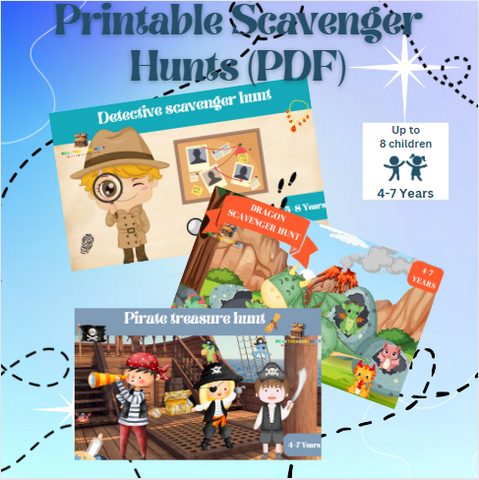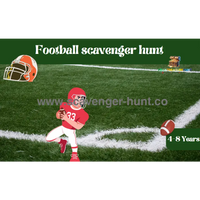Scavenger hunts are a great way to keep kids entertained and engaged, even when you’re confined indoors. With a bit of creativity and planning, you can turn your home into a thrilling adventure land. Here are four creative indoor scavenger hunt ideas to inspire you.
What Is a Scavenger Hunt?
A scavenger hunt is a game where players or teams are given a list of specific items or tasks to find and complete within a certain timeframe. The goal is to gather all the items or finish all the tasks before time runs out. Scavenger hunts can take place in various settings, and when done indoors, they provide a perfect solution for rainy days or cozy home gatherings.
Follow These Basic Steps for a Successful Scavenger Hunt
A successful scavenger hunt requires careful planning and preparation to ensure that it is fun, engaging, and safe for all participants. Here’s a more detailed look at each step:
Choose a Theme:
Selecting a theme for your scavenger hunt will make it more engaging and cohesive. Themes like pirates, detectives, jungle explorers, or seasonal hunts can add excitement and a sense of adventure. The theme will guide the design of your clues, decorations, and final treasure, making the experience more immersive and enjoyable for the participants.
Create a List:
Develop a list of items to find or tasks to complete that align with your chosen theme. For younger children, use simple words or pictures. For older children, you can include riddles or more complex clues. Make sure the items are diverse and interesting to keep the participants engaged throughout the hunt.
Set Boundaries:
Define the area where the hunt will take place. For indoor hunts, this could be specific rooms or sections of your house. Ensure the area is safe and manageable, especially for younger children. Clearly communicate the boundaries to all participants to prevent any confusion or safety issues.
Establish Rules:
Make sure all participants understand the rules and objectives of the scavenger hunt. Outline how they should conduct themselves, what they are looking for, and any specific instructions for completing tasks. Emphasize the importance of teamwork, respect for the environment, and playing fair. Setting clear rules helps maintain order and ensures everyone has a good time.
Gather Supplies:
Ensure participants have everything they need for the scavenger hunt, such as bags to collect items, notepads to jot down clues or findings, and cameras if the hunt involves taking photos. Preparing all necessary materials in advance will help the hunt run smoothly and efficiently.
Plan for Safety:
Especially if younger children are involved, plan for supervision and establish check-in points. Assign adults or older children to supervise and assist the participants. Make sure everyone knows where to find help if needed and establish a system for regular check-ins to ensure all participants are safe and accounted for.
With these steps in mind, let’s dive into some creative indoor scavenger hunt ideas.


Easy Indoor Scavenger Hunt
An easy indoor scavenger hunt is perfect for younger children or first-time hunters. The focus is on simple, easily recognizable items that are fun to find.
Planning the Hunt
Items to Include:
- A spoon
- A toy car
- A red book
- A pair of socks
- A stuffed animal
Instructions:
Create a Simple List: Use pictures along with words to help younger children understand what they’re looking for. Visual aids can make it easier and more engaging for them.
Define a Safe Area: Keep the hunt confined to a small, safe area like the living room or playroom. Ensure there are no hazardous spots where kids could get hurt.
Set a Time Limit: Give them plenty of time to find all the items without feeling rushed. This allows them to enjoy the process and explore their surroundings.
Tips for Success:
Supervision: Always have adults nearby to supervise and assist if needed. This ensures safety and helps maintain order.
Encouragement: Offer lots of positive reinforcement and celebrate each discovery. Praise their efforts to keep them motivated and excited.
An easy indoor scavenger hunt is a great way to introduce kids to the joy of exploring and completing challenges in a safe, controlled environment.
Educational Indoor Scavenger Hunt
An educational indoor scavenger hunt combines fun with learning, making it perfect for school activities or educational playdates.
Planning the Hunt
Items to Include:
- A book with a specific letter in the title
- A kitchen utensil that starts with “S”
- A piece of clothing with numbers on it
- A framed photo of a family member
- A toy that makes noise
Instructions:
Create Educational Clues: Provide clues that teach something about each item. For example, “Find a utensil that helps you stir ingredients when cooking.”
Use Learning Materials: Supply kids with simple guidebooks or charts to help them identify and understand items. This could include alphabet charts, number guides, or simple encyclopedias.
Set Learning Goals: Have clear objectives for what you want the kids to learn during the hunt. This could include vocabulary, numbers, or basic concepts.
Tips for Success:
Interactive Learning: Encourage kids to ask questions and discuss their findings. Make it a learning experience by explaining the purpose and use of each item they find.
Prizes for Learning: Offer small rewards for correct identifications and interesting observations. This motivates them to pay attention and remember what they’ve learned.
An educational scavenger hunt can turn a simple indoor activity into a valuable learning experience that stimulates curiosity and knowledge.
Ideas for Indoor Scavenger Hunts
When planning indoor scavenger hunts, consider incorporating a variety of themes and challenges to keep the kids engaged and excited. Here are some additional ideas to inspire you:
Seasonal Scavenger Hunts
-
Spring: Find items related to renewal and growth, such as a flower in a vase, a picture of a sunny day, or a fresh fruit.
-
Summer: Look for beach-themed items like sunglasses, a beach ball, or a picture of the ocean.
-
Autumn: Collect items that reflect the fall season, like a leaf-shaped decoration, a pumpkin, or a cozy blanket.
-
Winter: Search for winter-related items such as a snow globe, a pair of mittens, or a hot cocoa mug.
Themed Scavenger Hunts
-
Color Hunt: Focus on finding items of specific colors around the house.
-
Shape Hunt: Look for objects of different shapes like circles, squares, and triangles.
-
Alphabet Hunt: Find items that start with each letter of the alphabet.


Photography Indoor Scavenger Hunt
A photography scavenger hunt adds a creative twist, encouraging kids to capture their findings with a camera or smartphone.
Planning the Hunt
Items to Include:
- A unique shadow on the wall
- A close-up of a textured surface
- A reflection in a mirror
- A colorful toy arrangement
- A funny face made from objects
Instructions:
Provide Cameras: If possible, provide kids with disposable cameras or let them use smartphones under supervision. Ensure they understand how to use the devices safely and effectively.
Create a Photo List: List items or scenes they need to photograph. This can include specific objects, patterns, or creative interpretations.
Explain Basic Photography: Teach kids simple tips for taking good photos, like focusing and framing. Briefly explain concepts like lighting and composition to help them take better pictures.
Tips for Success:
Safety First: Ensure kids understand not to wander too far and to stay in safe areas. Supervise them to prevent accidents and guide them in handling the equipment.
Encourage Creativity: Let kids interpret the items creatively and capture interesting perspectives. Praise their unique ideas and creative shots.
A photography scavenger hunt not only engages kids in a fun activity but also helps them develop basic photography skills and a new way of observing their surroundings.
Tips for Success
-
Safety First: Ensure kids understand not to wander too far and to stay in safe areas. Supervise them to prevent accidents and guide them in handling the equipment.
-
Encourage Creativity: Let kids interpret the items creatively and capture interesting perspectives. Praise their unique ideas and creative shots.
A photography scavenger hunt not only engages kids in a fun activity but also helps them develop basic photography skills and a new way of observing their surroundings.
Indoor Treasure Scavenger Hunt
An indoor treasure scavenger hunt is a more elaborate and thrilling version, perfect for birthdays or special occasions. This type of hunt adds an element of adventure and excitement as kids work together to follow clues and discover hidden treasures.
Planning the Hunt
Items to Include:
-
Treasure Maps: Design detailed maps that guide participants from one clue location to the next.
-
Hidden Clues: Craft clues that lead to various spots within the designated area.
-
Small Treasures or Tokens: Place small rewards or tokens at each clue location, culminating in a final big treasure.
Instructions:
Create a Treasure Map: Design a map that leads to various clue locations and ultimately the final treasure. Make the map visually appealing and easy to follow.
Hide Clues and Treasures: Place clues in creative spots around the chosen area. Each clue should lead to the next, with small treasures or tokens hidden along the way.
Provide Final Treasure: The final treasure should be something exciting and worth the hunt. A treasure chest filled with goodies, toys, themed prizes, or even a special birthday gift works well. Decorate the chest to make it look enticing and hide it in a spot that provides a satisfying conclusion to the hunt.
Tips for Success:
Team Effort: Divide kids into teams to encourage cooperation and teamwork. This can make the hunt more competitive and fun, especially if you have a large group. Provide each team with their own map and clues or have them work together on a single quest.
Costumes and Props: Enhance the experience by encouraging kids to dress up according to the theme. Pirate hats, spyglasses, and bandanas can add to the adventure and make the event more immersive. Props like treasure chests, old-looking keys, and fake gold coins can also make the hunt more exciting.


Create Your Own Scavenger Hunt
Creating your own scavenger hunt offers a fantastic opportunity to craft a unique and memorable experience for children. Whether you’re hosting a birthday party, a playdate, or just a fun activity at home, designing your own scavenger hunt allows you to customize the experience based on your setting and the interests of the kids. Here’s a detailed guide to help you create a successful and enjoyable scavenger hunt from start to finish.
Choose Your Theme
The theme of your scavenger hunt sets the tone for the entire event and can make it more engaging and immersive for the participants. A well-chosen theme will influence the design of your clues, the decorations, and even the final treasure. Here are some popular themes and ideas for your scavenger hunt:
Pirates
-
Clues: Use treasure maps with X marks the spot, pirate lingo, and references to famous pirates.
-
Decorations: Pirate flags, treasure chests, and eye patches.
-
Final Treasure: Gold coins, pirate-themed toys, or a chest filled with goodies.
Jungle Explorers
-
Clues: Include animal tracks, jungle plants, and tropical fruits.
-
Decorations: Green streamers, jungle animals, and explorer hats.
-
Final Treasure: Animal figurines, explorer gear, or jungle-themed snacks.
Detectives
-
Clues: Use magnifying glasses, fingerprint clues, and mystery cases.
-
Decorations: Detective hats, clue boards, and wanted posters.
-
Final Treasure: Magnifying glasses, detective notebooks, or mystery-themed puzzles.
Fairy Tales
-
Clues: Include characters from classic fairy tales, magical creatures, and enchanted objects.
-
Decorations: Fairy lights, castles, and fairy wings.
-
Final Treasure: Fairy tale books, magical wands, or themed figurines.
Space Adventure
-
Clues: Focus on planets, aliens, and space missions.
-
Decorations: Space-themed banners, star stickers, and astronaut helmets.
-
Final Treasure: Space-themed toys, glow-in-the-dark stars, or alien figurines.
Tips for Choosing a Theme:
-
Interest: Pick a theme that resonates with the age group and interests of the children.
-
Flexibility: Choose a theme that can be adapted to your available space and resources.
-
Involvement: Engage the kids in the theme through costumes, props, and immersive activities.
Design Clues and Tasks
Designing clues and tasks is a crucial part of creating an engaging scavenger hunt. The clues should be age-appropriate and match the chosen theme to keep the kids entertained and challenged.
Creating Clues for Different Ages
-
Younger Children:
-
Picture Clues: Use images to show what they need to find.
-
Simple Rhymes: Create easy-to-follow rhymes related to the theme.
Example for Pirates:
-
Clue: “I’m where you keep your snacks and drinks, look inside for your next clue!” (Answer: The kitchen pantry)
-
Older Children:
-
Complex Riddles: Use more intricate riddles or puzzles.
-
Physical Challenges: Include tasks like jumping jacks or solving puzzles.
Example for Detectives:
-
Clue: “To find the next clue, you must solve this riddle: I have keys but no locks, I have space but no room. What am I?” (Answer: A keyboard)
Types of Clues and Tasks:
-
Riddles: Short puzzles that lead to the next clue.
-
Puzzles: Simple jigsaw puzzles that reveal the next location.
-
Physical Challenges: Activities like hopping on one foot or a mini-obstacle course.
-
Photo Challenges: Tasks where children must take pictures of specific objects or scenes.
Tips for Designing Effective Clues:
-
Clear Instructions: Ensure clues are easy to understand.
-
Test the Clues: Try them out to make sure they work as intended.
-
Engagement: Make clues fun and thematic to keep kids excited.
Set Up the Hunt
Setting up the scavenger hunt is where your planning comes to life. Proper setup ensures that the clues are hidden effectively and the experience is enjoyable for everyone involved.
Hiding Clues and Treasures
-
Hide Clues Creatively: Place clues in spots that align with the theme. For example, pirate clues could be hidden in a “buried” spot or inside a treasure chest.
-
Final Treasure: Ensure the final treasure is well-hidden but accessible. A satisfying discovery at the end of the hunt will complete the adventure.
Setup Checklist:
-
Create a Treasure Map: Design a map showing the locations of the clues and final treasure.
-
Hide Clues: Place clues in creative and safe spots.
-
Prepare the Final Treasure: Arrange the final prize in a special location.
Tips for a Smooth Setup:
-
Organize Ahead: Set up everything in advance to avoid last-minute issues.
-
Safety First: Make sure all hiding spots are safe and accessible.
-
Be Prepared: Have extra supplies and a backup plan for unexpected issues.
Gather Supplies
Having the right supplies is essential for a successful scavenger hunt. Gather everything you need to create a fun and engaging experience for the children.
Essential Supplies:
-
Clue Cards: Write or print the clues and tasks.
-
Treasure Maps: Design and print maps for the scavenger hunt.
-
Final Treasure: Prepare the final prize or treasure chest.
-
Costumes and Props: Gather any themed costumes or props for added fun.
-
Bags or Baskets: Provide containers for collecting found items.
Additional Supplies:
-
Notepads and Pens: For jotting down clues or observations.
-
Cameras or Smartphones: If including a photo challenge.
-
Timers: To keep track of time for the hunt.
Tips for Gathering Supplies:
-
Make a List: Create a checklist to ensure you have everything you need.
-
Shop Early: Get supplies in advance to avoid last-minute shopping.
-
Check Quality: Ensure all items are safe and in good condition.
Explain Rules and Safety
Before starting the scavenger hunt, clear communication of the rules and safety guidelines ensures a smooth and enjoyable experience for everyone.
Explaining the Rules
-
Gather Participants: Bring everyone together and explain the rules.
-
Discuss Boundaries: Clearly define the areas where the hunt will take place.
-
Explain the Objective: Make sure everyone understands the goal of the scavenger hunt.
Safety Guidelines:
-
Supervision: Ensure adults or older children are supervising the activity.
-
Teamwork: Encourage kids to work together and help each other.
-
Emergency Plan: Have a plan in case of accidents or emergencies.
Sample Rules:
-
“Work Together: If you’re in teams, help each other find clues.
-
“Stay in the Area: Don’t go outside the designated play zone.
-
“Have Fun: Enjoy the scavenger hunt and celebrate your discoveries!
Tips for Effective Communication:
-
Be Clear: Use simple language and demonstrate examples.
-
Be Encouraging: Make the rules sound exciting and fun.
-
Be Available: Be ready to answer questions and offer hints if needed.
Create Your Own Scavenger Hunt: A Personalized Adventure
Creating your own scavenger hunt offers a unique way to engage kids in a themed adventure tailored to their interests. By choosing a theme, designing creative clues, and setting up the hunt thoughtfully, you can craft an experience that is both fun and memorable. This activity fosters teamwork, problem-solving skills, and offers a wonderful opportunity for children to explore and enjoy their surroundings.
Example Scavenger Hunt Themes and Ideas:
-
Pirates: “Find the Hidden Treasure,” “Map to the X,” “Pirate Booty.”
-
Jungle Adventure: “Explorer’s Quest,” “Wild Animal Search,” “Jungle Safari.”
-
Detectives: “Solve the Mystery,” “Detective Challenge,” “Case of the Missing Clues.”
-
Fairy Tales: “Enchanted Quest,” “Fairy Tale Adventure,” “Magical Kingdom.”
Benefits of Creating Your Own Scavenger Hunt:
-
Customization: Tailor the hunt to the children’s interests and the environment.
-
Engagement: Create a memorable experience with themes and creative clues.
-
Learning: Incorporate educational elements into a fun activity.
-
Celebration: A great way to celebrate special occasions or just have fun.
Scavenger Hunt FAQs
What are some good scavenger hunt ideas for grandparents?
For grandparents, consider themes that are nostalgic or simple. Ideas include:
-
Memory Lane: Collect items from different decades.
-
Family History: Find pictures or objects related to family history.
-
Garden Quest: Look for specific plants or garden tools.
How can I do an online scavenger hunt?
An online scavenger hunt can be engaging with virtual clues and challenges:
-
Digital Clues: Use email or social media for clues.
-
Virtual Tasks: Include online challenges like finding information or completing trivia.
-
Photo Challenges: Participants upload photos of specific items or scenes.
How can I plan a scavenger hunt?
Planning a scavenger hunt involves:
-
Choosing a Theme: Pick something fun and engaging.
-
Designing Clues: Create age-appropriate clues and tasks.
-
Setting Up: Prepare the area and gather supplies.
-
Explaining Rules: Clearly communicate the rules and safety measures.
Creating a scavenger hunt is a wonderful way to provide children with a memorable and fun-filled experience. With careful planning and creativity, you can craft an adventure that will be enjoyed by everyone involved. Happy scavenger hunting!
Scavenger Hunt FAQs
What are some good scavenger hunt ideas for grandparents?
Grandparents can enjoy scavenger hunts with their grandchildren by focusing on intergenerational themes. For example, include items related to family history, such as an old photograph, a piece of jewelry, or a favorite family recipe. This can turn the hunt into a bonding experience, allowing grandparents to share stories and memories with the younger generation.
How can I do an online scavenger hunt?
An online scavenger hunt can be conducted using video conferencing tools and a list of virtual tasks. Participants might need to find items in their homes and show them on camera, solve digital puzzles, or take photos of specific objects and upload them. Use breakout rooms for team activities and set clear instructions and time limits to keep the hunt engaging.
How can I plan a scavenger hunt?
Planning a scavenger hunt involves several key steps:
-
Choose a Theme: Decide on a fun and engaging theme.
-
Create a List: Make a list of items to find or tasks to complete.
-
Design Clues: Craft age-appropriate and theme-related clues.
-
Set Boundaries: Define the area for the hunt.
-
Gather Supplies: Collect all necessary materials.
-
Explain Rules: Ensure all participants understand the rules and objectives.
-
Supervise and Assist: Be available to help participants and ensure safety.
Conclusion
Organizing an indoor scavenger hunt offers a fantastic way to bring excitement and adventure into your home. By following these creative ideas and practical tips, you can craft an engaging experience that fosters creativity, learning, and teamwork among children. Whether you opt for a simple scavenger hunt with everyday items or a more elaborate treasure quest, you have the tools to make the event enjoyable and memorable.
Indoor scavenger hunts are versatile and can be tailored to any occasion, from birthdays to rainy day activities. They provide a great opportunity for children to explore their surroundings, solve puzzles, and work together, all while having fun. Embrace the chance to turn your space into a realm of imagination and discovery.
Happy scavenger hunting!
Related Articles
Discover our Complete Scavenger Hunts Collection.


HOW TO PLAN A TREASURE HUNT FOR KIDS









































